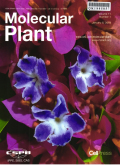- 钛学术文献服务平台 \
- 学术期刊 \
- 基础科学期刊 \
- 生物科学期刊 \
- 分子植物(英文版)期刊 \
Two birds with one stone: CEPR2 phosphorylates dual targets in ABA signaling
Two birds with one stone: CEPR2 phosphorylates dual targets in ABA signaling
基本信息来源于合作网站,原文需代理用户跳转至来源网站获取
摘要:
Abscisic acid (ABA) is a major phytohormone that governs plant development and their responses to many stressors (Chen et al., 2020).After its biosynthesis in specific tissues and ceils, ABA is transported throughout the plant and perceived by dedicated receptors.The PYR/PYL/RCAR (pyrabactin resistance1/PYR1-like/regulatory components of ABA receptor) proteins are such ABA receptors and are localized inside the cell.Due to their location, and since ABA is often biosynthesized far from its target cells, ABA transporters are needed to move the phytohormone from the cells that synthesize ABA to the target cells.Several ABA transporters from various protein families have been reported over the years: ABC (ATP-binding cassette), NPF (NITRATE TRANSPORTER1 [NRT1]/PEPTIDE TRANS-PORTER [PTR] FAMILY), and DTX/MATE (detoxification efflux carriers/muitidrug and toxic compound extrusion) transporters (Kang et al., 2020).Thus, three steps constitute the major framework of ABA signaling and control the diverse physiological and developmental effects of ABA: synthesis (mediated by enzymes), transport (mediated by transporters), and perception (mediated by receptors).

推荐文章
The influence of urbanization on karst rivers based on nutrient concentration and nitrate dual isoto
Urbanization
Urban river
Nitrate isotopes
Southwestern China
Chengguan River
一种基于XML的One to One营销优化建模方法
One to One营销优化模型
XML
DOM
自定义建模
一类One to One营销优化模型及其解决方案
One to One营销优化
优化模型
线性规划算法
MATLAB
一类One to One安排优化问题及其进化算法
遗传算法
安排问题
组合优化
局部搜索
内容分析
关键词云
关键词热度
相关文献总数
(/次)
(/年)
引文网络
引文网络
二级参考文献 (35)
共引文献 (3)
参考文献 (5)
节点文献
引证文献 (0)
同被引文献 (0)
二级引证文献 (0)
1998(1)
- 参考文献(0)
- 二级参考文献(1)
2005(1)
- 参考文献(0)
- 二级参考文献(1)
2006(1)
- 参考文献(0)
- 二级参考文献(1)
2009(5)
- 参考文献(0)
- 二级参考文献(5)
2010(4)
- 参考文献(0)
- 二级参考文献(4)
2011(1)
- 参考文献(0)
- 二级参考文献(1)
2012(3)
- 参考文献(1)
- 二级参考文献(2)
2013(6)
- 参考文献(0)
- 二级参考文献(6)
2014(7)
- 参考文献(1)
- 二级参考文献(6)
2015(6)
- 参考文献(0)
- 二级参考文献(6)
2016(1)
- 参考文献(0)
- 二级参考文献(1)
2018(3)
- 参考文献(2)
- 二级参考文献(1)
2019(1)
- 参考文献(1)
- 二级参考文献(0)
2021(0)
- 参考文献(0)
- 二级参考文献(0)
- 引证文献(0)
- 二级引证文献(0)
引文网络交叉学科
相关学者/机构
期刊影响力
分子植物(英文版)
主办单位:
中科院上海生命科学研究院植物生理生态所
中国植物生理学会
出版周期:
月刊
ISSN:
1674-2052
CN:
31-2013/Q
开本:
出版地:
上海市岳阳路319号31B楼
邮发代号:
创刊时间:
语种:
eng
出版文献量(篇)
1996
总下载数(次)
1
总被引数(次)
17663
期刊文献
相关文献
推荐文献
- 期刊分类
- 期刊(年)
- 期刊(期)
- 期刊推荐
力学
化学
地球物理学
地质学
基础科学综合
大学学报
天文学
天文学、地球科学
数学
气象学
海洋学
物理学
生物学
生物科学
自然地理学和测绘学
自然科学总论
自然科学理论与方法
资源科学
非线性科学与系统科学
分子植物(英文版)2022
分子植物(英文版)2021
分子植物(英文版)2020
分子植物(英文版)2019
分子植物(英文版)2018
分子植物(英文版)2017
分子植物(英文版)2016
分子植物(英文版)2015
分子植物(英文版)2014
分子植物(英文版)2013
分子植物(英文版)2012
分子植物(英文版)2011
分子植物(英文版)2010
分子植物(英文版)2009
分子植物(英文版)2008
分子植物(英文版)2021年第8期
分子植物(英文版)2021年第7期
分子植物(英文版)2021年第6期
分子植物(英文版)2021年第5期
分子植物(英文版)2021年第4期
分子植物(英文版)2021年第3期
分子植物(英文版)2021年第2期
分子植物(英文版)2021年第1期

 免费查重
免费查重










